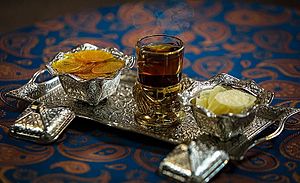Poolaki facts for kids
 |
|
| Type | Confectionery |
|---|---|
| Place of origin | |
| Region or state | Isfahan |
| Main ingredients | Sugar, water, white vinegar, natural flavours (saffron, dried lime or cocoa powder) |
Poolaki (pronounced Poo-lah-kee) is a special kind of candy from Iran. It's mostly made in the city of Isfahan. Imagine a very thin, round disc, almost like a tiny coin. That's what Poolaki looks like! It's so thin that it quickly melts in your mouth.
This sweet treat is made from simple ingredients. These include sugar, water, and a little white vinegar. For different tastes, natural flavours are added. These can be saffron, dried lime, or even cocoa powder. Poolaki is a bit like a thin, crispy toffee. The name "Poolaki" comes from the Persian word "Poolak," which means "small coin."
What is Poolaki?
Poolaki is a traditional Iranian confectionery. It is known for its unique shape and texture. Unlike many candies, Poolaki is very delicate. It is designed to dissolve quickly. This makes it a popular choice to enjoy with hot drinks.
How Poolaki is Made
Making Poolaki starts with boiling sugar and water. A small amount of white vinegar is added. This helps to give the candy its clear, thin texture. Once the mixture is ready, it is poured onto a flat surface. It spreads out into very thin layers. As it cools, it hardens into the coin-like discs.
Popular Flavours
Poolaki comes in several delicious flavours. The most common ones are:
- Saffron Poolaki: This type has a beautiful golden colour. It gets its taste from saffron, a valuable spice.
- Dried Lime Poolaki: This flavour offers a slightly tangy taste. It uses dried lime powder.
- Cocoa Poolaki: For chocolate lovers, this version includes cocoa powder. It gives the candy a rich, sweet flavour.
Poolaki in Iranian Culture
In Iran, Poolaki is often served with tea. It's a common sight in homes and at gatherings. People place a piece of Poolaki in their mouth. Then, they sip their hot tea. The candy slowly melts, adding a sweet taste to the drink. This tradition is a big part of Iranian hospitality. It shows how simple sweets can bring people together.

